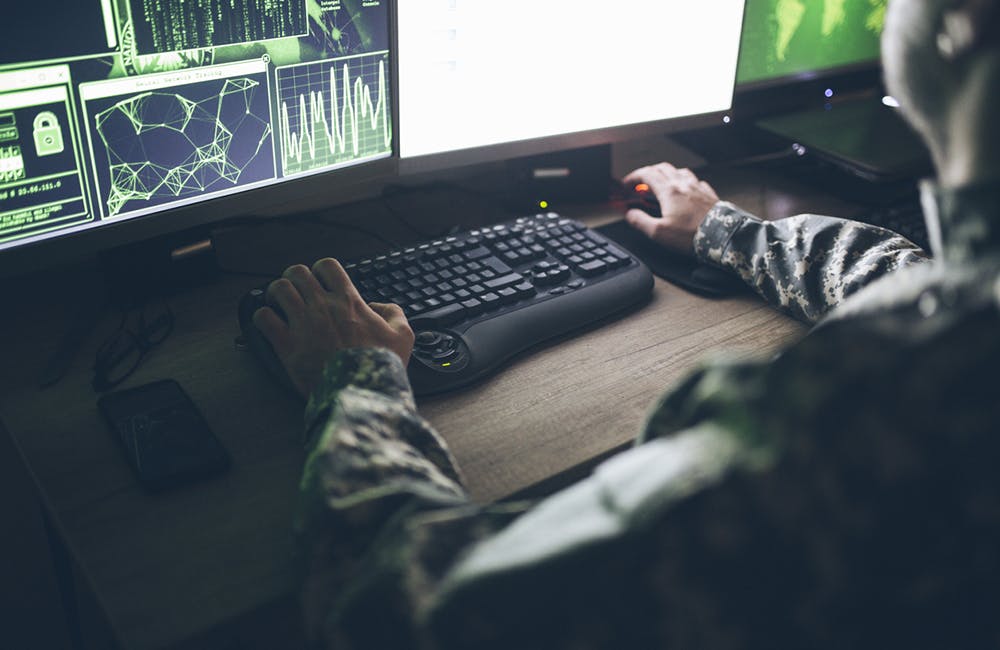DOD’s Keys to Unlocking Data Are Cloud, Zero Trust, AI
Delivering data ‘at the speed of need’ requires more visibility and usability.

Unlocking the potential of data is a critical endeavor at the Defense Department, and officials are investing in cloud, automated capabilities and zero-trust cybersecurity to store, optimize and protect data in a modernized fashion.
“Data provides us a competitive advantage over our adversaries,” Army Undersecretary James McPherson said at Tuesday’s AFCEA Army Signal Conference. “As with any strategic asset, we must manage and protect our data, and we do this through a hybrid of multiple-cloud ecosystems.”
“Combined with a reliable secure and resilient network infrastructure and aided by artificial intelligence and machine learning, timely access to trusted data will shorten the commander’s decision cycle, enabling better decision-making,” Army Cyber Commander LTG. Stephen Fogarty added. “To be effective, data must be delivered on demand, quickly and automatically. Effective data management requires a reliable and secure data infrastructure and data storage supported by hybrid systems to optimize the benefits of the cloud while allowing greater control and security.”
While DOD continues to work toward hybrid multi-cloud IT infrastructures, a zero-trust cybersecurity approach will also be critical to securing that environment, Fogarty added. Defense Information Systems Agency Cloud Portfolio Manager John Hale advocated a similar approach during Wednesday’s FCW DOD Cloud Workshop.
Securing data with zero-trust cybersecurity is essential with the push to cloud-based services and applications, Hale said. DISA and DOD are looking to increase software-as-a-service (SaaS) in particular, which has compelled Hale’s team to evolve from defense-in-depth security to zero trust and zero trust architectures (ZTA).
“Zero trust and ZTA models are going to push us to where we put more and more requirements on SaaS providers in order to meet our security requirements,” Hale said.
The “as-a-service” model that cloud capabilities offer will also aid defense officials in consolidating their networks and data. Fogarty said that Army Cyber Command’s (ARCYBER) data is largely stored in disparate, siloed infrastructure, making it difficult to query data across systems and easier to waste resources and deployment time for making decisions. As ARCYBER looks to integrate and consolidate its data assets, Fogarty wants to move toward enterprise-IT-as-a-service.
“Command-centric network operations will also be part of establishing a global enterprise command and control structure, which will depend on critical initiatives, including enterprise-IT-as-a-service,” Fogarty said. “Enterprise-IT-as-a-service, or ITaaS, is foundational to command-centric network operations.”
Army Futures Command is largely leading the Army in this network modernization effort, creating an integrated tactical network for improved battlefield communications and integrated enterprise networking driven by cloud business and infrastructure services and applications. Army Futures Command AI Task Force Director Brig. Gen. Matt Easley highlighted during a Tuesday ATARC conference the role of the cloud in getting a handle on data to improve AI capabilities and push modernization forward.
“We’re bringing in a whole series of cloud technicians, so we understand how to move our data from our signature systems from the battlefield from a distributor environment, up to a cloud environment to do analytics, and then, again, eventually do AI and machine-learning models, and then move those models and the inference part back down to the edge,” Easley explained.
The Navy has also seen benefits from the cloud in scaling up and expanding data-sharing capabilities in its modernization efforts. Although the Navy was already eyeing the cloud, the mass move to telework with COVID-19 created massive networking demands across the enterprise, and a cloud infrastructure supported the needed network and data-sharing environment for successful remote work, Navy Program Manager Capt. Ben McNeil said.
“We not only need to support Navy, [but also] military folks, civilian folks, also our defense industrial base — our partners around the Navy all have a need to be able to carry with us to be able to share data,” McNeil said. “Our modernization and transformation effort is geared toward building a network the Navy needs to supply the cloud, to be able to support.”
Underlying all of these modernization efforts, regardless of the pressure that COVID-19 has created across the military, is the need to safeguard and optimize data.
“Data must be systemically collected from many platforms and sources, consolidated and stored securely,” Fogarty said. “Transporting data to decision-makers and other users will depend on having an integrated backbone network that is secure, reliable, resilient and adaptable form the enterprise to the tactical edge and back when they can operate in a contested information environment. An integrated network will also help break down data silos, enable interoperability and deliver data at the speed of need.”
This is a carousel with manually rotating slides. Use Next and Previous buttons to navigate or jump to a slide with the slide dots
-

Generative AI Demands Federal Workforce Readiness, Officials Say
NASA and DOI outline new generative AI use cases and stress that successful AI adoption depends on strong change management.
6m read -

The Next AI Wave Requires Stronger Cyber Defenses, Data Management
IT officials warn of new vulnerabilities posed by AI as agencies continue to leverage the tech to boost operational efficiency.
5m read -

Federal CIOs Push for ROI-Focused Modernization to Advance Mission Goals
CIOs focus on return on investment, data governance and application modernization to drive mission outcomes as agencies adopt new tech tools.
4m read -

Fed Efficiency Drive Includes Code-Sharing Law, Metahumans
By reusing existing code instead of rewriting it, agencies could dramatically cut costs under the soon-to-be-enacted SHARE IT Act.
5m read -

Agencies Push Data-Driven Acquisition Reforms to Boost Efficiency
New initiatives aim to increase visibility of agency spending, improve data quality and create avenues to deploy solutions across government.
5m read -

Data Transparency Essential to Government Reform, Rep. Sessions Says
Co-Chair of the Congressional DOGE Caucus Rep. Pete Sessions calls for data sharing and partnerships to reduce waste and improve efficiency.
5m read -

DOD Turns to Skills-Based Hiring to Build Next-Gen Cyber Workforce
Mark Gorak discusses DOD’s efforts to build a diverse cyber workforce, including skills-based hiring and partnerships with over 480 schools.
20m listen -

AI Foundations Driving Government Efficiency
Federal agencies are modernizing systems, managing risk and building trust to scale responsible AI and drive government efficiency.
40m watch -

Trump Executive Order Boosts HBCUs Role in Building Federal Tech Workforce
The executive order empowers HBCUs to develop tech talent pipelines and expand access to federal workforce opportunities.
3m read -

Navy Memo Maps Tech Priorities for the Future Fight
Acting CTO’s memo outlines critical investment areas, from AI and quantum to cyber and space, as part of an accelerated modernization push.
5m read -

DOD Can No Longer Assume Superiority in Digital Warfare, Officials Warn
The DOD must make concerted efforts to address cyber vulnerabilities to maintain the tactical edge, military leaders said at HammerCon 2025.
4m read -

New NSF Program Cultivates the Future of NextG Networks
The agency’s new VINES program looks to tackle key challenges like energy efficiency and future-proofing wireless tech.
21m watch
















